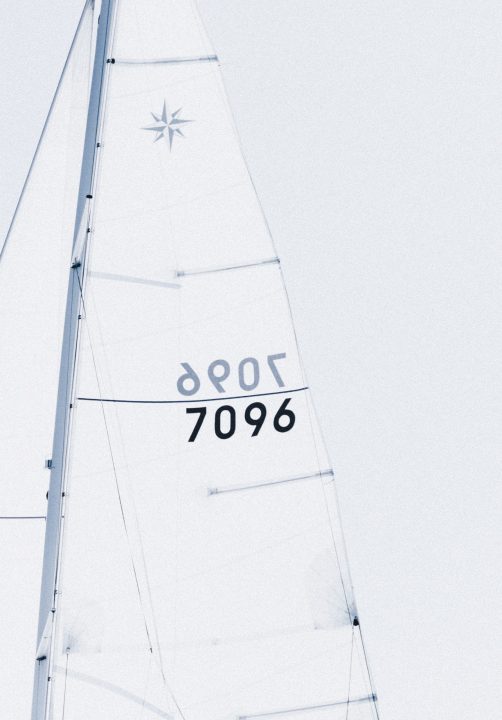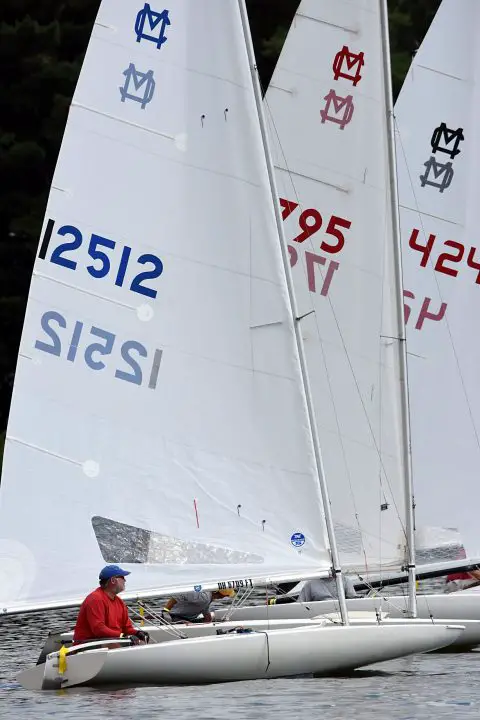Have you ever noticed how most sailboats have numbers on their sails? It’s one of those small details that you might not think much about.
But depending on what sort of boat you run, those numbers might carry a lot of meaning. Pretty much every boat has sail numbering, but they mean different things to different sailors.
Here’s a look at what those numbers mean and how to choose and install them if you’re ready to be noticed on the water.

Table of Contents
- What Are Sail Numbers and What Do They Mean?
- Four Types of Sailboat Numbers
- How To Pick Your Numbers
- How to Apply Sailboat Numbers
- Sail Numbers and Numbers of Sails
- FAQs – Questions About Sail Numbering
What Are Sail Numbers and What Do They Mean?
First off, the purpose of sailboat numbers is solely to make your boat easily identifiable from a long way away. In many instances, a group of sailboats looks indistinguishable from one another from shore. Numbers are usually shown on the mainsail, but many racing boats have them installed on every sail they have.
One thing that sail numbering is not is an official registration or documentation number. There are some cases when the number is unique and traceable, but not by any legal state authority.
In most cases, the cruising sailor will say, “so what?” But if you think about it, sail numbers can help another boat identify you and call you on the radio. For example, instead of calling the “White hulled sailboat off of Cape Henry,” a ship could call “Sailboat number 99 near Cape Henry.” That’s a lot more specific and a lot more likely to get your attention. Sail numbers are very easy to read through binoculars, after all.
In contrast, racing sailors are often identified by their numbers. In a racing class, where every boat is identical, the only distinguishing attribute on the entire boat is the number on the sails.
The same is true in the offshore racing world. Many offshore racers have unique numbers assigned by the racing governance boards in their home countries.
Four Types of Sailboat Numbers
So let’s take a closer look at the various types of numbers that might be displayed on a boat’s sails.
Factory Numbers
This one is for most cruising boats. When the boat is delivered from the factory, they install sails made by their sailmaker. These will always include the boat maker’s logo and some identifying number. Usually, this is a sequential hull number.
For example, my boat displays the distinctive CR38, indicating that it is a Cabo Rico 38. The number 99 refers to the boat’s hull number off of the factory line. Therefore, it is the 99th Cabo Rico 38 that the company made.
This system is entirely random, of course. A builder might choose a different scheme to use or put no numbers on the sails at all.
On another note, sails don’t last forever. Most sailors have to buy new sails every decade or so, and in doing so, no rule says they need to stick with the same numbering scheme the manufacturer did.
One-Design or Class Numbers (Like International Laser Class Association)
For class racing, the numbers are significant because they are often the only way to tell the boats apart while they’re on the water. The whole idea of class racing is that the boats are identical, and only the sailor’s skills win the race.
Each class association issues numbers and class rules dictate precisely how and where the number is displayed.. For example, the International Optimtimis Dinghy Association (IODA) issues numbers for several small classes.

Racing Yachts and Sail Number Racing Rules
If larger boats are raced offshore in big competitions, it is usually registered with their home country’s national authority. Here in the US, that’s US Sailing. National letters or a country code will usually precede the unique sail number.
US Sailing works with regional associations around the country to ensure that sail numbers are not duplicated. But, of course, there are also large parts of the country that a regional club doesn’t cover, and in those cases, numbers are issued directly from US Sailing.
These US numbers are five digits long. The last four digits are divided up among the regional clubs. So, for example, USA 03000 would be assigned to someone from the Chesapeake Bay Yacht Racing Association.
Cruising Boats – Owner’s Choice
What if the boat isn’t raced in any official events? As described above, maybe the factory installed the hull number or some other digits of significance. But if those sails are shot and it’s time for new ones, what should the skipper do?
They could choose to do nothing. If sail numbers aren’t crucial in what you do—and they aren’t for most liveaboard and traveling sailors—then you could simply not install any.
Or, you could mimic what the factory did. For example, the company insignia and number on the sail might be meaningful to you, like the maker’s badge on the hood of your car. In that case, you can have it recreated by the sail loft when they build your sails.
Or, you could do something completely original and meaningful to you and your crew. Sail lofts are using modern materials and dyes now that can make sails with printed patterns and graphics.
Many cruising sailors have designed their own logos for use on their sails. One famous example is SV Delos, whose sails feature their YouTube channel’s brand graphics and look great in their videos.

How To Pick Your Numbers
So if you have a cruising boat and need to pick some numbers, how do you figure out what to choose? If you’re buying a new sail, the sail maker can usually help you decide.
But the choice is entirely up to you. You could pick numbers of personal significance, like your birthday or anniversary. You could pick numbers about your boat, like the date you purchased her, her make and model dimensions, or the hull number.
If you don’t know your boat’s hull number, it is usually found in the middle of the HIN, which is the boat’s official hull identification number. The HIN is molded into the boat’s transom and included on all official paperwork. If your boat is registered or documented, the HIN is on the paperwork.
The first few digits of the HIN correspond to the country of origin and the manufacturer. In the middle, there should be a model code or serial number. Finally, the last four digits of the HIN are the date that the boat’s keel was laid by the factory.
How to Apply Sailboat Numbers
If you ever want to apply your own sail numbers, it’s not hard to do. For the most part, they are made with self-adhesive lettering protected by backing paper. The biggest considerations are to ensure that the adhesive is strong enough and that material is pliable enough to be folded with the sail.
You can purchase lettering and logo material from most sail lofts or chandleries. You can also purchase pre-made block letters and numbers specifically intended for sails.
When putting the numbers on the sail, ensure that they are spaced perfectly. You’ll also want to think about how the sail will look when backlit by the sun. You can see the numbers on opposite sides, so you don’t want to let them overlap. Doing so would make both sets illegible on both the port side and starboard side.
Stingy Sailor has a great how-to on making and applying sail numbers.
Sail Numbers and Numbers of Sails
Finally, we should note one final source of possible confusion. On racing sailboats, different sails are often referred to by different numbers! This isn’t an identification number specific to the boat, like the numbers discussed above.
Instead, this is a style of sail. Sails are numbered based on the wind conditions that they’re best for. Quantum Sails has a good write-up about the different shapes of jib sail and the numbers that correspond to them.
Many cruising sails may be familiar with the Code 0 (zero) sail, suitable for light air. This is an example of this numbering system used on racing boats.
FAQs – Questions About Sail Numbering
What does sail number mean?
Sail numbers mean different things on different boats. They are simply a way to identify a particular boat from a distance.
On racing boats, the numbers help spectators tell who’s winning—and who’s not. On cruising boats, the numbers are often random and chosen by the boat manufacturer or owner.
How do I identify my sailboat?
Boat’s are commonly identified by a HIN, or hull identification number. This number isn’t found on the sails but rather molded into the boat’s fiberglass hull. It’s usually located somewhere on the transom.
The HIN works just like the VIN (vehicle identification number) in a car. It is unique to that boat and used on all official paperwork, like the registration. You can decode the HIN to find the manufacturer, serial number, and date of manufacture.
What is a number 4 sail?
On racing boats, different-sized headsails are given different numbers. For example, a number 4 jib is a small heavy air sail used in windy conditions.
Racers are always looking for an advantage, so like a golfer might choose a different club for a long drive, a skipper might call for a different sail combination to better match the wind speed and angle.
